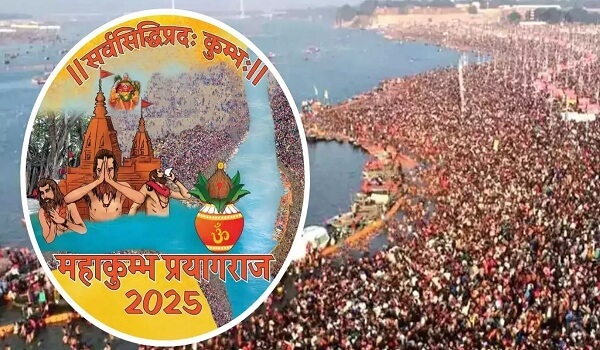The Maha Kumbh Mela in 2025 will be held in Prayagraj from 13 January to 26 February 2025, which will attract millions of pilgrims as a symbol of spiritual purification, cultural celebration and unity. The word ‘Kumbh’ is derived from the metal ‘kumbhaka’ (sacred pitcher of the nectar of immortality).
Key Facts about Kumbh Mela
It is the largest peaceful congregation of pilgrims during which the participants take a bath or dip in the holy river. This congregation takes place at 4 different places, namely:
- On the banks of the Ganges at Haridwar.
- On the banks of the Shipra River at Ujjain.
- On the banks of the Godavari (South Ganga) at Nasik.
- At the confluence of the Ganges, Yamuna and the mythical invisible Saraswati at Prayagraj.
Different Types of Kumbh
- Kumbh Mela is celebrated 4 times in 12 years.
- The Ardh Kumbh Mela is held every sixth year at Haridwar and Allahabad.
- The Maha Kumbh Mela is celebrated at Prayag after 144 years (after 12 ‘Purna Kumbh Melas’).
- The Magh Kumbh is celebrated annually in the month of Magh (January-February) at Prayagraj.
Historical Evolution
- Background: The Maha Kumbh Mela, composed by Adi Shankaracharya, has its origins in the Puranas which describe the struggle between the gods and demons for the sacred pitcher of Amrit, in which Lord Vishnu (in the form of Mohini) saved the pitcher from the demons.
- Ancient Origins: The Kumbh Mela began as a small gathering of pilgrims from all over the Indian subcontinent during the Mauryan and Gupta periods (4th century BC to 6th century AD).
- It gained importance with the rise of Hinduism (especially under rulers like the Guptas, who gave it even more prominence).
- Medieval Patronage: It was supported by royal dynasties such as the Chola and Vijayanagara Empires, the Delhi Sultanate and the Mughals.
- Akbar gave the Naga Sadhus the honour of leading the royal entourage to the fair in 1565 in order to promote religious tolerance.
- King Harshavardhana of the Pushyabhuti dynasty started the Kumbh Mela in Prayagraj.
- Colonial period: Impressed by the significance and diversity of the Kumbh Mela, British administrators observed and documented the festival.
- In the 19th century, James Prinsep described its ritual practices and socio-religious dynamics.
- Post-independence significance: The Kumbh Mela is a symbol of national unity and cultural heritage of India which was recognised by UNESCO in 2017 as an Intangible Cultural Heritage of Humanity for its ancient traditions.
3 Guinness World Records of Kumbh 2019
- Largest traffic and crowd management plan.
- Largest painting exercise of public places under Paint My City scheme.
- Largest sanitation and waste disposal system.
Significance of Kumbh
- Spiritual relevance: It is believed that bathing in the holy waters of Triveni Sangam (confluence of Ganga, Yamuna, Saraswati) brings freedom from sins and guides towards spiritual liberation (moksha).
- Cultural performances: Devotional kirtans, bhajans and traditional dances like Kathak, Bharatanatyam and Kuchipudi at the Kumbh Mela highlight themes of spiritual unity and divine love.
- Astrological significance: Determined based on the position of the Sun, Moon and Jupiter, the event is highly auspicious for spiritual activities.
- In Nashik and Ujjain, the fair is held when a planet is in Leo, which is called Simhastha Kumbh.
Rituals and Activities
- Royal Bath: Saints and Akharas take a ceremonial bath accompanied by a procession, also known as ‘Rajyogi Snan’, it marks the beginning of the Maha Kumbh Mela.
- The word ‘Akhada’ is derived from ‘Akhand’, meaning indivisible. Adi Guru Shankaracharya sought to unify ascetic organizations to protect the ‘Sanatan’ way of life.
- Akharas are symbols of social order, unity, culture and morality, focusing on spiritual and ethical values. They emphasize virtue, ethics, self-restraint, compassion and righteousness and are a symbol of unity in diversity.
- Akharas can be classified based on their presiding deity.
- Shaivite Akharas: worship Lord Shiva in various forms.
- Vaishnavite Akharas: worship Lord Vishnu in various forms.
- Udasi Akhada: Founded by Chandra Dev (son of the first Sikh Guru, Guru Nanak).
- Peshwai Procession: A grand spectacle of the traditional procession of the Akhadas, known as ‘Peshwai’, includes participants on elephants, horses and chariots.
- Spiritual Discourses: The event includes spiritual discourses by revered saints and spiritual leaders as well as a lively fusion of Indian music, dance and crafts.
UNESCO Intangible Cultural Heritage List
- This prestigious list is made up of intangible heritage elements that help showcase the diversity of cultural heritage and raise awareness about its importance.
- The list was established in the year 2008 when the Convention for the Safeguarding of the Intangible Cultural Heritage came into force.

